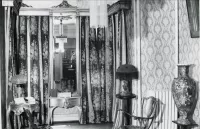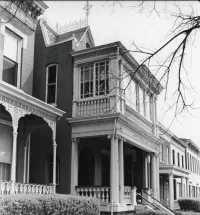Share what you know,
and discover more.
Share what you know,
and discover more.
May 12, 1975

-

- Charmaine Bantugan
National Register of Historic Places - Maggie Lena Walker House (Maggie L. Walker National Historic Site)
Statement of Significant: The Maggie Walker House was the home of a woman prominent in the business and charitable activities of the black community of Richmond. A founder and guiding force in many organizations, Mrs. Walker is believed to have been the first American woman bank president. Furthermore, the house with its contents offers a rare view of late-Victorian urban life. Maggie L. Walker (1867-1934) was the daughter of a slave in the household of Elizabeth Van Lew, a prominent Union sympathizer during the War between the States. Educated at the Lancaster School and at the Armstrong Normal School, she married building contractor Armistead Walker, Jr. after she was graduated in 1883. She soon became an agent for Women's Union Insurance and at the same time entered into the activities of the Independent Order of St. Luke, a black fraternal and cooperative insurance society. In 1902, she began publishing the St. Luke Herald. That same year, the order established the St. Luke Penny Savings Bank with Mrs. Walker as president. This bank absorbed all the other black banks in Richmond in 1929-1930 and became the Consolidated Bank and Trust Company. She served as chairman of the new institution until shortly before her death five years later. Maggie Walker was also interested in several philanthropic endeavors among Richmond's black population. For example, she was prominent in the effort to raise money to found the Virginia Industrial School for Colored Girls, now the Janie Porter Barrett School. Maggie Walker's efforts earned many honors for her, including an honorary degree from Virginia Union University. A high school in Richmond is named after her. In addition to its connection with Maggie Walker, her house is an important example of late-Victorian material culture. Preserved essentially as it was when she died, with all of its furnishings intact and in place, it provides an invaluable resource for the study of black middle-class culture in early- twentieth-century America.
National Register of Historic Places - Maggie Lena Walker House (Maggie L. Walker National Historic Site)
Statement of Significant: The Maggie Walker House was the home of a woman prominent in the business and charitable activities of the black community of Richmond. A founder and guiding force in many organizations, Mrs. Walker is believed to have been the first American woman bank president. Furthermore, the house with its contents offers a rare view of late-Victorian urban life. Maggie L. Walker (1867-1934) was the daughter of a slave in the household of Elizabeth Van Lew, a prominent Union sympathizer during the War between the States. Educated at the Lancaster School and at the Armstrong Normal School, she married building contractor Armistead Walker, Jr. after she was graduated in 1883. She soon became an agent for Women's Union Insurance and at the same time entered into the activities of the Independent Order of St. Luke, a black fraternal and cooperative insurance society. In 1902, she began publishing the St. Luke Herald. That same year, the order established the St. Luke Penny Savings Bank with Mrs. Walker as president. This bank absorbed all the other black banks in Richmond in 1929-1930 and became the Consolidated Bank and Trust Company. She served as chairman of the new institution until shortly before her death five years later. Maggie Walker was also interested in several philanthropic endeavors among Richmond's black population. For example, she was prominent in the effort to raise money to found the Virginia Industrial School for Colored Girls, now the Janie Porter Barrett School. Maggie Walker's efforts earned many honors for her, including an honorary degree from Virginia Union University. A high school in Richmond is named after her. In addition to its connection with Maggie Walker, her house is an important example of late-Victorian material culture. Preserved essentially as it was when she died, with all of its furnishings intact and in place, it provides an invaluable resource for the study of black middle-class culture in early- twentieth-century America.
May 12, 1975
National Register of Historic Places - Maggie Lena Walker House (Maggie L. Walker National Historic Site)
Statement of Significant:The Maggie Walker House was the home of a woman prominent in the business and charitable activities of the black community of Richmond. A founder and guiding force in many organizations, Mrs. Walker is believed to have been the first American woman bank president. Furthermore, the house with its contents offers a rare view of late-Victorian urban life.
Maggie L. Walker (1867-1934) was the daughter of a slave in the household of Elizabeth Van Lew, a prominent Union sympathizer during the War between the States. Educated at the Lancaster School and at the Armstrong Normal School, she married building contractor Armistead Walker, Jr. after she was graduated in 1883.
She soon became an agent for Women's Union Insurance and at the same time entered into the activities of the Independent Order of St. Luke, a black fraternal and cooperative insurance society. In 1902, she began publishing the St. Luke Herald. That same year, the order established the St. Luke Penny Savings Bank with Mrs. Walker as president. This bank absorbed all the other black banks in Richmond in 1929-1930 and became the Consolidated Bank and Trust Company. She served as chairman of the new institution until shortly before her death five years later.
Maggie Walker was also interested in several philanthropic endeavors among Richmond's black population. For example, she was prominent in the effort to raise money to found the Virginia Industrial School for Colored Girls, now the Janie Porter Barrett School.
Maggie Walker's efforts earned many honors for her, including an honorary degree from Virginia Union University. A high school in Richmond is named after her.
In addition to its connection with Maggie Walker, her house is an important example of late-Victorian material culture. Preserved essentially as it was when she died, with all of its furnishings intact and in place, it provides an invaluable resource for the study of black middle-class culture in early- twentieth-century America.
Posted Date
Jul 14, 2023
Historical Record Date
May 12, 1975
Source Name
National Register of Historic Places
Source Website
Delete Story
Are you sure you want to delete this story?











